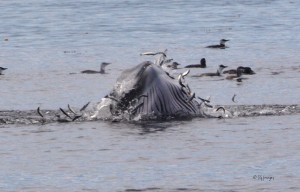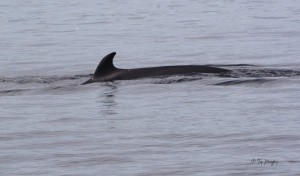The Minke (pronounced mink-ee) Balaenoptera acutorostrata whale is the smallest of the baleen whales, the largest being the Blue whale, which we’ll get to on their own page. Although the Minke is stated as being the most abundant of the whale species, they are not seen as frequently as one would think. They are in all the oceans, but there are differences. The Dwarf form is considered to reside solely in the Southern hemisphere. The Antarctic form has greyish rather than white markings. And the Pacific and Atlantic Ocean forms of the Minke whale are considered to be the “Common” or “True” Minke, and the ones we see in the coastal waters of BC.
Since Minke whales do not stay near the surface for long, they are not as easy to spot as some of the other whales. They seem to take one or two quick breaths then they’re gone. It takes a sharp and very patient eye to spot the usually lone whale with a small dorsal that tends to disappear for ten or more minutes between breaths. In that time, they can travel a great distance. Minke whales seldom breach, leap from the water, have a relatively low blow, breath spout, and do not fluke, show their tail, the way Humpbacks do when they dive.
Although there are reports of curious Minke whales approaching boats and kayaks, they are usually quite shy and usually disappear quickly. My underwater camera captured one on film when it swam by to check out the camera dangling in the water. I didn’t even know it was in the area, nor did I see it surface after, although I was looking. I will be posting that video at a later date.
Minke whales, like the other baleen whales, feed by taking a large gulp of water and small fish or krill, miniature shrimp like critters. They too have pleats that allow their throat to expand to accommodate the volume of water and food. The Minke then uses its tongue to push the water out through the baleen filter and swallows the meal. They frequently use the lunge feeding technique, lunging through a school of fish or krill with mouth wide open to maximize the number they catch.
Minke whale populations have been diminished through whaling and they continue to be the most hunted species of whale. It is unknown as to the Minke’s actual numbers, but based on sightings dwindling over the past ten years, I believe that hunting has taken a serious toll on their populations.
Minke Whale – Balaenoptera acutorostrata Specifics:
Length:
up to 10 m (33 ft)
Weight:
up to 9,000 kg (20,000 lbs)
Colour:
Dark grey to black back lighter on flanks
Light chevron behind head
White band across top of pectoral flippers
Frequently very light grey to white underneath
Features:
Slender torpedo shaped body
Very pointed head
Ventral throat pleats
Curved dorsal fin two-thirds of way along back





